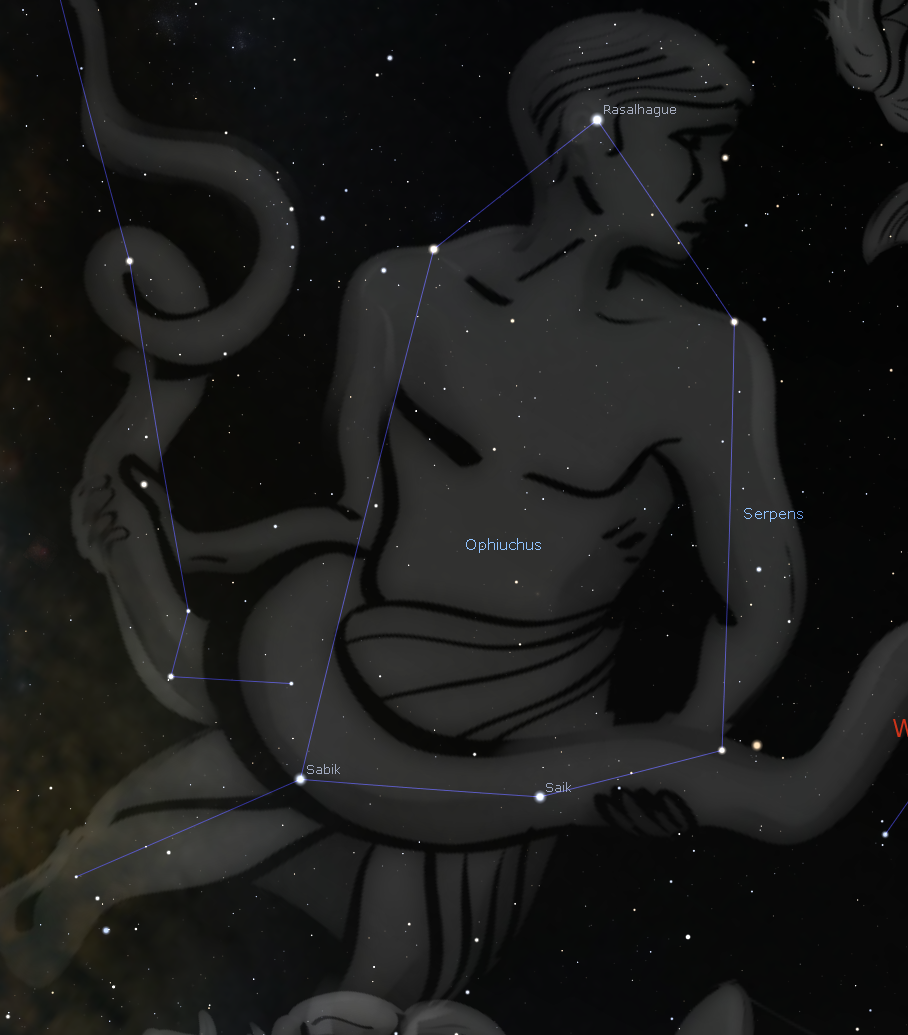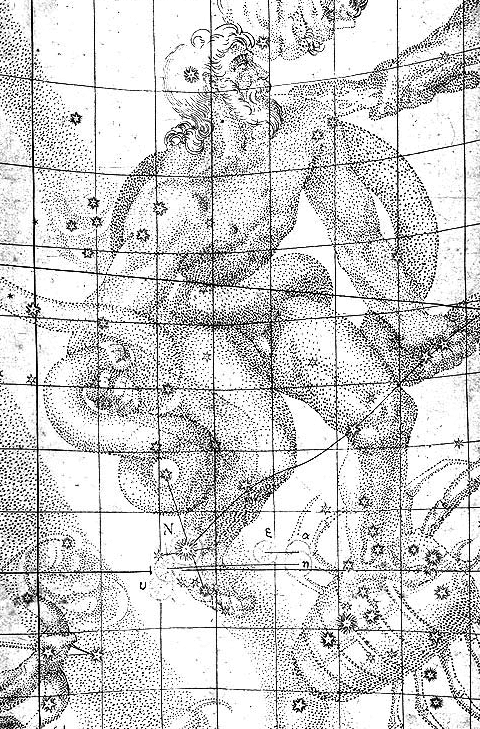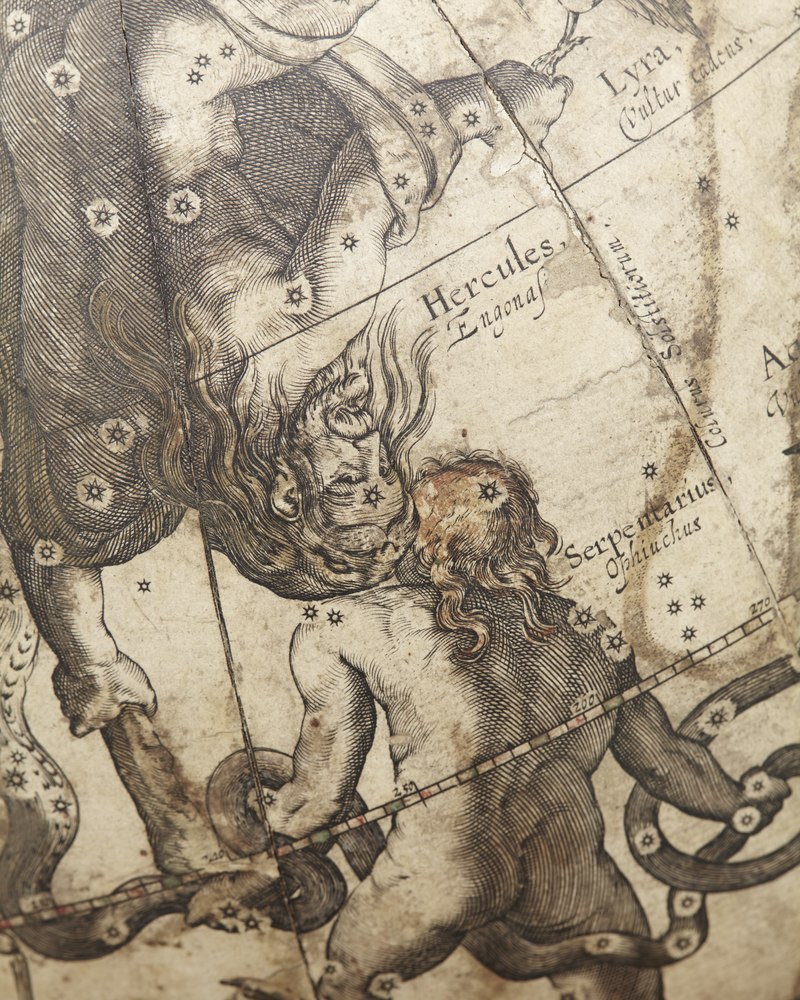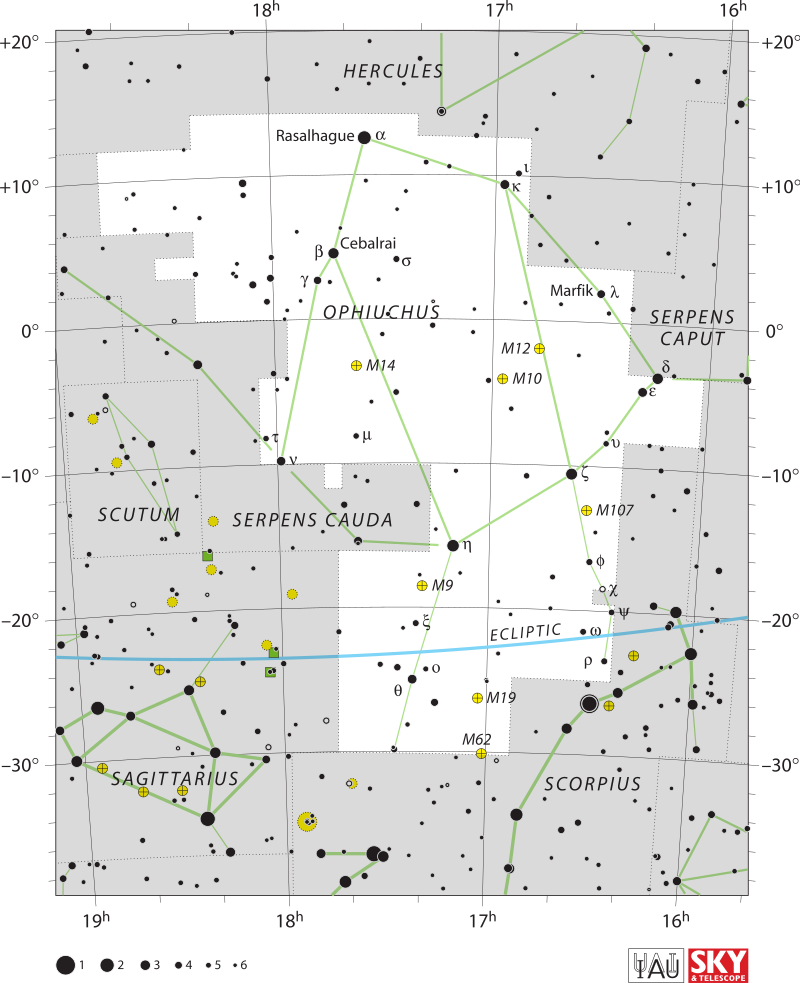|
Large constellation Ophiuchus crosses the celestial equator. Its name, which means "serpent-bearer," derives from the Ancient Greek ὀφιoῦχος (ophioûkhos), and it is sometimes shown as a man holding a snake. The constellation Serpens is a representation of the serpent. Ophiuchus is still one of the eighty-eight constellations that are recognised today. It was one of the forty-eight constellations that the 2nd-century astronomer Claudius Ptolemy recorded. Serpentarius was once another name for the constellation.
|
Location
Northwest of the Milky Way's nucleus, between Aquila, Serpens, Scorpius, Sagittarius, and Hercules, is Ophiuchus. Between Sagittarius to the east and Scorpius to the west is where the southern portion is located. (Dickinson 2006) Summertime in the northern hemisphere is when it is most visible. (Dickinson 2006) It stands across from Orion. In the image of Ophiuchus, a man holding a serpent, Serpens Caput and Serpens Cauda are separated from the Serpens constellation by the man's body. Ophiuchus is an equatorial constellation having most of its surface in the southern hemisphere. Its brightest star, Rasalhague, is located at approximately +12° 30′ declinations, close to Ophiuchus' northern boundary. The constellation reaches 30° declination in the south. Ophiuchus contains portions of the ecliptic that are south of 20° declination.
In contrast to Orion, which is visible from most latitudes from November to January (summer in the Southern Hemisphere, winter in the Northern Hemisphere), Ophiuchus is in the midday sky. The Sun is, however, behind the horizon even at midday for a substantial portion of the Arctic Circle during the winter months of the Northern Hemisphere. Around local noon, low in the south, stars (and thus, sections of Ophiuchus, especially Rasalhague) are then visible at twilight for a few hours. Ophiuchus is ordinarily visible in the night sky throughout the spring and summer months of the Northern Hemisphere; however, this is not the case because the midnight sun blocks out the stars in the Arctic during those seasons. Ophiuchus appears above in countries near the equator in June at midnight and in the evening sky of October.
Northwest of the Milky Way's nucleus, between Aquila, Serpens, Scorpius, Sagittarius, and Hercules, is Ophiuchus. Between Sagittarius to the east and Scorpius to the west is where the southern portion is located. (Dickinson 2006) Summertime in the northern hemisphere is when it is most visible. (Dickinson 2006) It stands across from Orion. In the image of Ophiuchus, a man holding a serpent, Serpens Caput and Serpens Cauda are separated from the Serpens constellation by the man's body. Ophiuchus is an equatorial constellation having most of its surface in the southern hemisphere. Its brightest star, Rasalhague, is located at approximately +12° 30′ declinations, close to Ophiuchus' northern boundary. The constellation reaches 30° declination in the south. Ophiuchus contains portions of the ecliptic that are south of 20° declination.
In contrast to Orion, which is visible from most latitudes from November to January (summer in the Southern Hemisphere, winter in the Northern Hemisphere), Ophiuchus is in the midday sky. The Sun is, however, behind the horizon even at midday for a substantial portion of the Arctic Circle during the winter months of the Northern Hemisphere. Around local noon, low in the south, stars (and thus, sections of Ophiuchus, especially Rasalhague) are then visible at twilight for a few hours. Ophiuchus is ordinarily visible in the night sky throughout the spring and summer months of the Northern Hemisphere; however, this is not the case because the midnight sun blocks out the stars in the Arctic during those seasons. Ophiuchus appears above in countries near the equator in June at midnight and in the evening sky of October.
|
History and Mythology
There is no proof that the constellation existed before the classical era, but according to Babylonian astronomy, a constellation called the "Sitting Gods" was visible near Ophiuchus. Gavin White, however, suggests that Ophiuchus might be a distant descendant of this Babylonian constellation, which stood for Nirah, a serpent-God who was occasionally seen with his upper half human but serpents for legs. (White 2008) The constellation is first mentioned in Aratus, which is supported by the illegible Eudoxus of Cnidus inventory from the fourth century BCE: “To the Phantom's back the Crown is near, but by his head mark near at hand the head of Ophiuchus, and then from it, you can trace the starlit Ophiuchus himself: so brightly set beneath his head appear his gleaming shoulders. They would be clear to mark even at the midmonth moon, but his hands are not at all so bright; for faint runs the gleam of stars along on this side and on that. Yet they too can be seen, for they are not feeble. Both firmly clutch the Serpent, which encircles the waist of Ophiuchus, but he, steadfast with both his feet well set, tramples a huge monster, even the Scorpion, standing upright on his eye and breast. Now the Serpent is wreathed about his two hands – a little above his right hand, but in many folds’ high above his left.” (Loosely translated by Mair 1921) The constellation was viewed by the ancient Greeks as the god Apollo battling a massive snake that was manning the Oracle of Delphi. (Thompson 2007) In subsequent tales, Ophiuchus was compared to Laocoön, the Poseidon-priesting Trojan who informed his fellow Trojans about the Trojan Horse before being killed by two sea serpents sent by the gods as retribution. The figure, according to mythology from the Roman era, represents the physician Asclepius, who discovered how to prevent death after witnessing one serpent carrying another therapeutic plant. Jupiter murdered Asclepius with a lightning strike to stop humanity from becoming eternal while under his care, but afterwards immortalised him in the skies as a reward for his heroic deeds. In Islamic astronomy of the time (Azophi's Uranometry). Ophiuchus is depicted by Aratus having trampled upon Scorpius with his feet. Beginning with Albrecht Dürer in 1515, this is shown in Renaissance to Early Modern star charts; in some representations (like that of Johannes Kepler in De Stella Nova, 1606), Scorpius also appears to be threatening to sting Serpentarius in the foot. This is in line with Azophi, who identified the snake-"left charmer's foot" as "Oph and Oph" and his "right foot" as "Oph and o Oph," making Ophiuchus a zodiacal constellation at least in terms of his feet. Later literature has interpreted this arrangement as symbolic and related it to the words God said to the serpent in the Garden of Eden (Genesis 3:15). (Maunder 1908) |
Zodiac
One of the thirteen constellations that cross the ecliptic is Ophiuchus. It has occasionally been called the "13th sign of the zodiac." However, this conflates constellations with zodiac or astrological signs. In the Western tradition, the signs of the zodiac are aligned with the seasons so that the March equinox always coincides with the dividing line between Pisces and Aries. The signs of the zodiac are a twelve-fold division of the ecliptic, with each sign spanning 30° of celestial longitude, roughly the distance the Sun travels in a month. (Campbell 2020) Contrarily, constellations are based on the positions of the stars and vary in size. The constellations of the zodiac only tangentially correspond to the signs of the zodiac, and they generally do not.
For instance, in Western astrology, Pisces and the constellation Aquarius are most closely related. Similarly, most of the sign of Sagittarius (23 November–21 December) is occupied by the constellation of Ophiuchus (29 November–18 December). The variations result from the fact that throughout the centuries since the Babylonians first created the Zodiac, the time of year when the Sun transits a specific zodiac constellation's location has steadily altered (due to the precession of the equinoxes). (Aitken 1942)
One of the thirteen constellations that cross the ecliptic is Ophiuchus. It has occasionally been called the "13th sign of the zodiac." However, this conflates constellations with zodiac or astrological signs. In the Western tradition, the signs of the zodiac are aligned with the seasons so that the March equinox always coincides with the dividing line between Pisces and Aries. The signs of the zodiac are a twelve-fold division of the ecliptic, with each sign spanning 30° of celestial longitude, roughly the distance the Sun travels in a month. (Campbell 2020) Contrarily, constellations are based on the positions of the stars and vary in size. The constellations of the zodiac only tangentially correspond to the signs of the zodiac, and they generally do not.
For instance, in Western astrology, Pisces and the constellation Aquarius are most closely related. Similarly, most of the sign of Sagittarius (23 November–21 December) is occupied by the constellation of Ophiuchus (29 November–18 December). The variations result from the fact that throughout the centuries since the Babylonians first created the Zodiac, the time of year when the Sun transits a specific zodiac constellation's location has steadily altered (due to the precession of the equinoxes). (Aitken 1942)
Deep-sky Objects
Main stars - 10
Bayer stars - 65
Stars with planets - 15
Stars brighter than magnitude 3.00 - 5
Stars within 32 Ly - 11
Bordering
constellations
Meteor showers
- IC 4665 – Open Cluster
- NGC 6633 – Open Cluster
- Messier 9 (M9) – Globular Cluster
- Messier 10 (M10) – Globular Cluster
- Messier 12 (M12) – Globular Cluster
- Messier 14 (M14) – Globular Cluster
- Messier 19 (M19) – Globular Cluster
- Messier 62 (M62) – Globular Cluster
- Messier 107 (M107) – Loose Globular Cluster
- IC 4603 – Reflection and Emission Nebula
- IC 4604 – Reflection Nebula
- NGC 6240 – Ultraluminous infrared Galaxy
- Barnard 68 – Dark nebula
Main stars - 10
Bayer stars - 65
Stars with planets - 15
Stars brighter than magnitude 3.00 - 5
Stars within 32 Ly - 11
Bordering
constellations
- Hercules
- Serpens Cauda
- Serpens Caput
- Libra
- Scorpius
- Sagittarius
- Aquila
Meteor showers
- Ophiuchids
- Northern May Ophiuchids
- Southern May Ophiuchids
- Theta Ophiuchids




